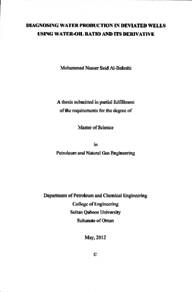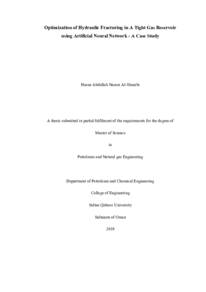وثيقة
Diagnosing water production in deviated wells using water-oil ratio and its derivative
الناشر
Sultan Qaboos University
ميلادي
2012
اللغة
الأنجليزية
الملخص الإنجليزي
Excessive water production is a common issue in the oil industry. It results in oil reduction, increased handling and intervention costs and is very difficult to control and reduce. Knowing the source of the excessive water can assist in applying water reduction methods or taking early action to shut in the well and save long term costs.
Diagnostic plots employ production data to identify various elements such as reservoir behavior and well performance and issues. One of these diagnostic plots is used for early screening of water production problems by use of water-oil ratio (WOR) and water-oil ratio derivative (WOR') to diagnose the issue as either channeling/fracture or coning/cusping phenomena. These plots are best used before applying any costly diagnostic methods such as Production Logging Tools (PLTs).
Early studies have shown that the diagnostic plots can be applied to vertical and horizontal wells with great success. Such success was proven both numerically and through actual historical data. Effectiveness of these diagnostic plots with deviated wells has not been investigated before.
In this study, a 3D numerical model was used to simulate deviated wells in channeling and coning/cusping environments. Results were plotted as WOR and WOR' vs. time in log-log plots which showed some variations but adhering to the trends for channeling and coning/cusping previously observed in vertical and horizontal wells. Results were validated using actual historical data from field data.
In addition, wellbore sensitivities were simulated to show the applicability of WOR and WOR' diagnostic plots in varying wellbore geometries such as: wellbore internal diameter and well lateral length.
المجموعة
URL المصدر
الملخص العربي
إنتاج المياه المصاحبة للنفط هي مشكلة شائعة في مجال النفط ينتج عنها انخفاض في إنتاج النفط وزيادة في التكاليف و صعوبة في التحكم والحد منها . إن معرفة مصدر المياه يمكن أن يساهم في تطبيق أساليب الحد من المياه أو إتخاذ تدابير مبكرة لإغلاق البئر وتوفير تكاليف على المدى البعيد.
تستخدم المخططات التشخيصية من أجل الفحص المبكر عن مشاكل إنتاج المياه عن طريق إستخدام نسبة المياه إلى النفط ومشتقاتها لتشخيص مصدر المشكلة إن كانت ظاهرة قنوات/كسر أو مخروط حول البئر . أفضل إستخدام لهذه المخططات يكون قبل تطبيق وسائل تشخیص مكلفة مثل أدوات تسجيل الإنتاج .
أظهرت الدراسات السابقة أن المخططات التشخيصية يمكن تطبيقها على الآبار العمودية والأفقية بنجاح كبير . وقد تم إثبات هذا النجاح من المحاكاة الرقمية ومن خلال البيانات التاريخية الفعلية للآبار . لكنه لم يتم التحقيق من فعالية هذه المخططات التشخيصية على الآبار المائلة من قبل .
لقد تم إستخدام نموذج محاكاة ثلاثي الأبعاد لمحاكاة مشكلة مصدر المياه في الآبار المائلة في بيئات القنوات العالية النفاذية و المخروطات المائية . النتائج تم عرضها على شكل نسبة المياه الى النفط ومشتقاتها في مخطط لوغاريثمي والتي أظهرت بعض الفروقات لكنها تمسكت بالإتجاهات الملحوظة سابقا في الآبار العمودية والأفقية . تم التحقق من صحة النتائج باستخدام البيانات التاريخية الفعلية لأبار حقيقية .
بالإضافة إلى ذلك ، فقد تم دراسة تأثر النتائج بطول البئر وقطرها الداخلي . أظهرت النتائج صلاحية مخططات التشخيص بإستخدام نسبة المياه الى النفط.
تستخدم المخططات التشخيصية من أجل الفحص المبكر عن مشاكل إنتاج المياه عن طريق إستخدام نسبة المياه إلى النفط ومشتقاتها لتشخيص مصدر المشكلة إن كانت ظاهرة قنوات/كسر أو مخروط حول البئر . أفضل إستخدام لهذه المخططات يكون قبل تطبيق وسائل تشخیص مكلفة مثل أدوات تسجيل الإنتاج .
أظهرت الدراسات السابقة أن المخططات التشخيصية يمكن تطبيقها على الآبار العمودية والأفقية بنجاح كبير . وقد تم إثبات هذا النجاح من المحاكاة الرقمية ومن خلال البيانات التاريخية الفعلية للآبار . لكنه لم يتم التحقيق من فعالية هذه المخططات التشخيصية على الآبار المائلة من قبل .
لقد تم إستخدام نموذج محاكاة ثلاثي الأبعاد لمحاكاة مشكلة مصدر المياه في الآبار المائلة في بيئات القنوات العالية النفاذية و المخروطات المائية . النتائج تم عرضها على شكل نسبة المياه الى النفط ومشتقاتها في مخطط لوغاريثمي والتي أظهرت بعض الفروقات لكنها تمسكت بالإتجاهات الملحوظة سابقا في الآبار العمودية والأفقية . تم التحقق من صحة النتائج باستخدام البيانات التاريخية الفعلية لأبار حقيقية .
بالإضافة إلى ذلك ، فقد تم دراسة تأثر النتائج بطول البئر وقطرها الداخلي . أظهرت النتائج صلاحية مخططات التشخيص بإستخدام نسبة المياه الى النفط.
قالب العنصر
الرسائل والأطروحات الجامعية


